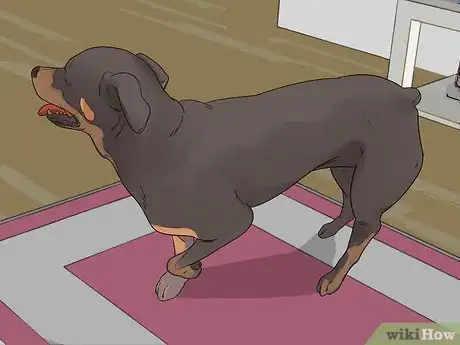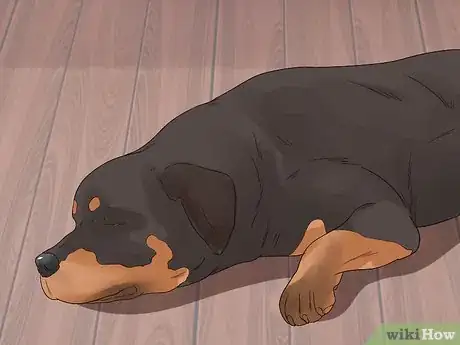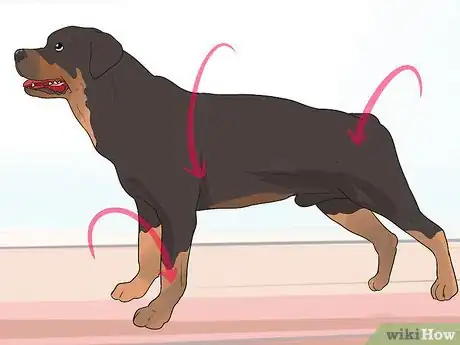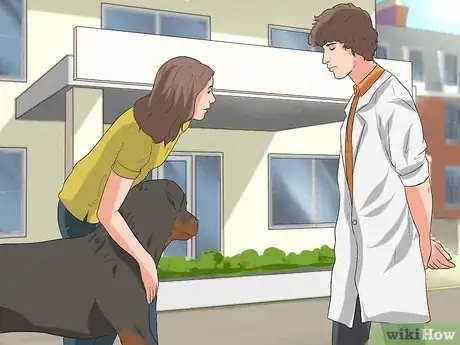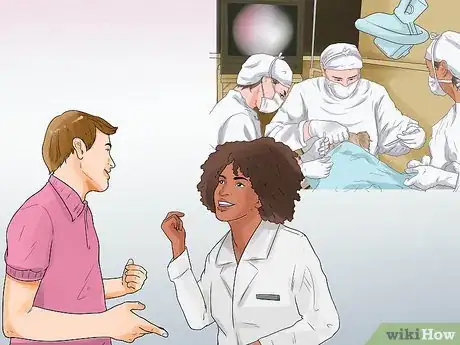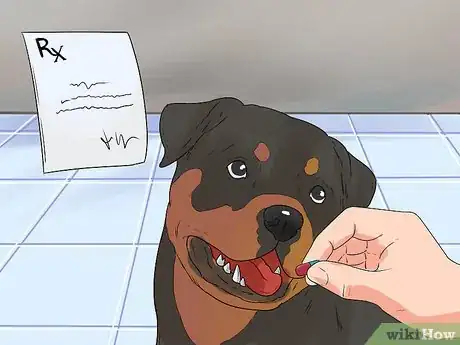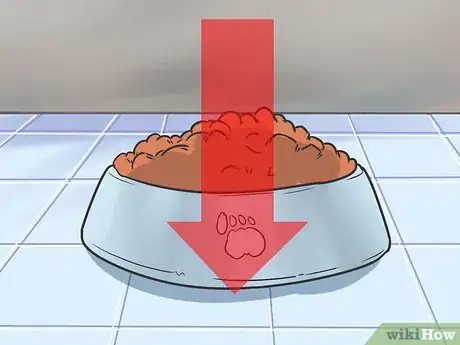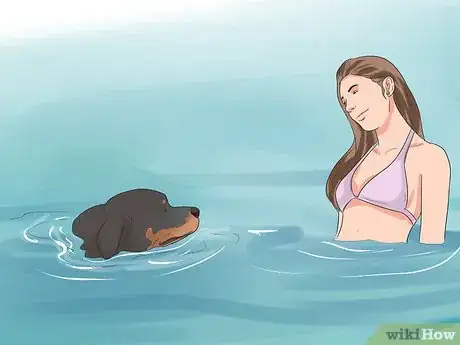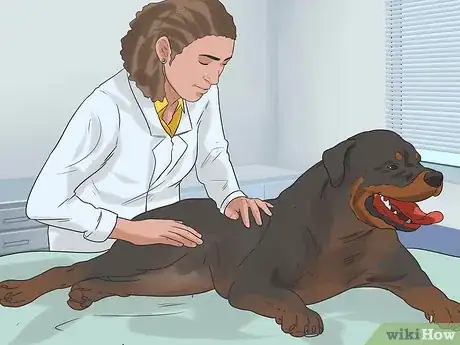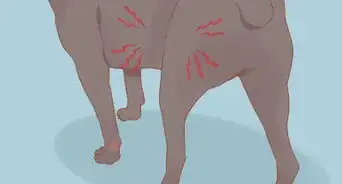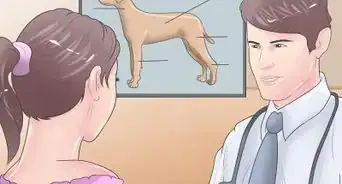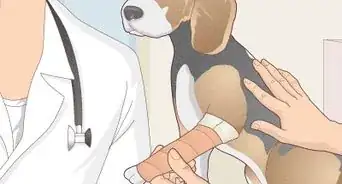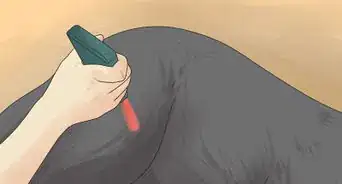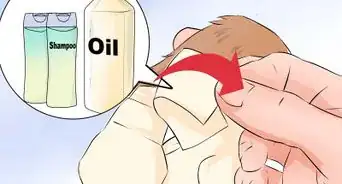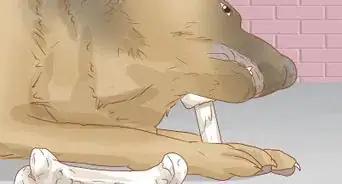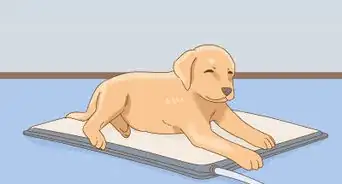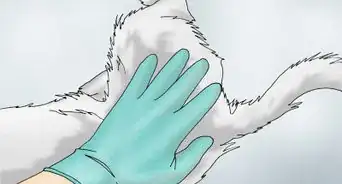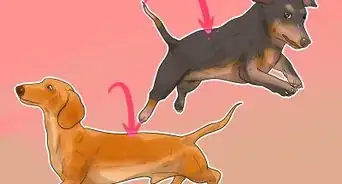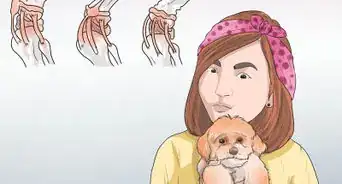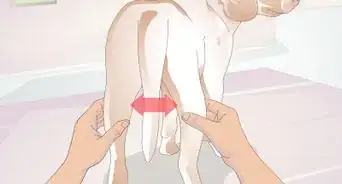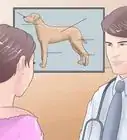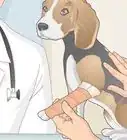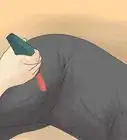This article was co-authored by Pippa Elliott, MRCVS. Dr. Elliott, BVMS, MRCVS is a veterinarian with over 30 years of experience in veterinary surgery and companion animal practice. She graduated from the University of Glasgow in 1987 with a degree in veterinary medicine and surgery. She has worked at the same animal clinic in her hometown for over 20 years.
There are 13 references cited in this article, which can be found at the bottom of the page.
This article has been viewed 22,639 times.
Arthritis, a condition affecting the joints, occurs commonly in dogs.[1] Large breed dogs, like Rottweilers, are more prone to developing arthritis because of how much they weigh—big dogs put more stress on their joints. If left untreated, arthritis could make your Rottweiler experience a lot of pain and prevent him from enjoying his normal activities. Treating his arthritis will help him feel better and more like a normal dog.
Steps
Recognizing Arthritis in Your Rottweiler
-
1Watch your Rottweiler move around. With arthritis, your Rottweiler’s joints start to break down and become inflamed. The subsequent pain and discomfort will likely keep him from being able to move around like he used to. For example, if he used to run and greet you at the door, he may now walk slowly towards the door or just stay where he is. If he used to walk up and down the stairs easily, arthritis may make him more cautious about using the stairs.[2]
- When he wakes up in the morning, or after a long nap, you may notice it takes him longer to stand up and get moving.[3]
- You may also notice him walking with a limp, indicating he is favoring one leg over another.
-
2Look for changes in your Rottweiler’s behavior. Joint pain and discomfort can take more than just a physical toll on your Rottweiler. He may become less alert.[4] In addition, he may become less interested in playing and start sleeping more.Advertisement
-
3Check your Rottweiler’s body condition. Arthritis can cause a dog to lose weight (due to a loss of appetite) or gain weight.[7] To assess your Rottweiler’s body condition, you will examine certain body parts, including his ribs, spine, hips, and waist. If he has gained a lot of weight, you will not be able to feel his ribs, spine, or hips. In addition, you won’t be able to see his waist.[8] [9]
- Weight gain can put even more stress on your Rottweiler’s joints, worsening his arthritis.
- Losing weight will produce the opposite results. His bones and waist would be very visible, indicating a loss of fat in those areas.
Seeking Veterinary Care
-
1Take your dog to your veterinarian. If left untreated, arthritis can decrease the range of motion in your Rottweiler’s joints, which could eventually lead to a loss of muscle tone and loose ligaments (structures that connect bones to each other). If you notice signs of arthritis lasting for 2 or more weeks, take your Rottweiler to your veterinarian for diagnosis and treatment. Your veterinarian will examine your Rottweiler’s joints and take x-rays to determine the location and severity of the arthritis.[10]
- During your appointment, provide as much information as you can about your Rottweiler’s symptoms and any other changes you’ve noticed.
-
2Discuss treatment options with your veterinarian. Arthritis can be difficult to treat and manage, so it will be important for you to know what treatments are available.[11] Arthritis treatment commonly involves several strategies, including weight management, exercise, pain control, and physical therapy.[12] Nutritional supplements (e.g., glucosamine, omega-3 fatty acids) can also help treat arthritis by improving joint health and reducing joint inflammation.[13]
- In severe cases of arthritis, surgical treatment (e.g., joint fusion, joint replacement) may be needed.[14]
-
3Devise a treatment plan for your Rottweiler with your veterinarian. Arthritis does not look the same from one dog to the other, so treatment must be individualized.[15] Your veterinarian will consider several factors, including your Rottweiler’s weight, mobility, and severity of arthritis, when making treatment recommendations. You should consider your time availability, as well as financial resources, when devising the treatment plan with your veterinarian.
- Discuss any concerns you may have about the treatment plan with your veterinarian. For example, if cost is an issue, he or she may able to recommend more affordable treatments.
- Treating your Rottweiler’s arthritis could become a long-term commitment.
Implementing the Treatment Plan
-
1Administer medications as prescribed. Medications to relieve pain and inflammation are key to treating arthritis. Veterinarians commonly prescribe non-steroidal anti-inflammatory drugs (NSAIDs; e.g., carprofen, meloxicam, deracoxib) for dogs with arthritis. Digestive problems (e.g., vomiting, gastrointestinal bleeding, loss of appetite) can occur with long-term NSAID usage, so your veterinarian may not have your Rottweiler on an NSAID for a long time.[16]
-
2Manage your Rottweiler’s weight. If your Rottweiler is overweight, losing weight will take some pressure off his joints and help relieve his arthritis. Since he won’t be able to do high-intensity exercises, weight loss should occur through dietary changes. The overall goal for the dietary changes is reduced caloric intake.
- Dietary changes include switching him to a weight loss diet (available at your local pet store or through your veterinarian) and not feeding him table scraps.[17] Switch his food out gradually so he does not develop digestive upset with the new food.
- You can also swap out high-calorie store-bought treats for fresh, healthy treats (e.g., banana and apple slices).[18]
- Simply feeding him less of his usual diet is not a good idea, since he may start missing out on key nutrients.[19]
- Ask your veterinarian what your Rottweiler’s ideal weight should be. Try weighing him once or twice a month to see if he is losing weight. If he is not losing weight, talk with your veterinarian about other weight loss strategies.
-
3Supplement your Rottweiler’s diet. Nutraceuticals, which are non-prescription food supplements, have gained popularity for treating arthritic dogs.[20] Nutraceuticals containing chondroitin and/or glucosamine, which help repair damaged joint cartilage, are widely used.[21]
- Several other supplements are available, including omega-3 fatty acids (anti-inflammatory function) and MSM (anti-inflammatory and pain reduction functions).[22]
- Not all supplements are created equal, so talk with your veterinarian before adding them to your Rottweiler’s diet.
-
4Exercise your Rottweiler each day. Exercise is a very beneficial treatment strategy for arthritis, since it improves mobility and flexibility, and builds muscle.[23] [24] Exercises should be low impact to minimize the wear and tear on your Rottweiler’s joints. Examples of good exercises are walking and slow jogging on grass, swimming, and going up and down stairs.
- Your veterinarian can recommend exercises that will be relatively easy for your Rottweiler to do.
- Each exercise session should last about 15 to 20 minutes. Aim for two exercise sessions per day.[25]
- Consider massaging your Rottweiler’s muscles before and after each exercise session.
-
5Massage and perform physical therapy on your Rottweiler. Massage and physical therapy are great for relaxing your Rottweiler’s stiff muscles, improving range of motion in his joints, and improving his muscle circulation.[26] [27] You can give your dog a fully body massage, or just focus on the arthritic area—your dog will likely appreciate the massage either way!
- To massage the arthritic area, lightly stroke the area with your hands. Next, use your palm to apply gentle pressure on the muscles around the joint (not the joint itself). Complete the massage by lightly stroking the area again.[28]
- Make the massage area comfortable by playing soft music, eliminating distractions, and placing a few layers of thick blankets on the ground.[29]
- If you have never given your Rottweiler a massage before, he may not be comfortable with it at first. Be patient with him as he gets used to your touch.
- Your veterinarian will recommend various physical therapy exercises for your Rottweiler.[30] If you are unsure how to perform them on your own, ask your veterinarian to demonstrate them for you.
-
6Modify your Rottweiler’s environment. Making your Rottweiler’s environment more comfortable is not exactly a treatment, but it will help him feel better. For example, elevate his food and water bowls so he does not have to bend down so far to eat and drink. In addition, build or purchase a ramp so he can go up and down stairs or get into and out of your car.[31]
- Consider purchasing an orthopedic foam bed, which distributes weight evenly, doesn’t create painful pressure points, and is easy to get into and out of. Put some extra blankets on the bed to keep your Rottweiler warm.
Warnings
- Do not give your Rottweiler Tylenol or Ibuprofen. In dogs, Tylenol may cause liver damage and Ibuprofen may cause gastrointestinal bleeding.[33]⧼thumbs_response⧽
- Intense exercise, or the wrong type of exercise, can make your Rottweiler’s arthritis worse.⧼thumbs_response⧽
- Severe arthritis can leave a dog completely unable to walk.[34]⧼thumbs_response⧽
References
- ↑ http://www.petmd.com/dog/general-health/evr_dg_arthritis_how_to_recognize_and_manage_the_condition?page=show#
- ↑ http://www.petmd.com/dog/general-health/evr_dg_arthritis_how_to_recognize_and_manage_the_condition?page=show#
- ↑ http://www.ivghospitals.com/specialty-services/osteoarthritis-and-rottweilers/
- ↑ http://www.petmd.com/dog/general-health/evr_dg_arthritis_how_to_recognize_and_manage_the_condition?page=show#
- ↑ http://www.okawvetclinic.com/top-10-ways-to-tell-if-your-pet-has-mild-arthritis.pml
- ↑ http://www.akcchf.org/canine-health/your-dogs-health/caring-for-your-dog/managing-canine-arthritis.html
- ↑ http://www.akcchf.org/canine-health/your-dogs-health/caring-for-your-dog/managing-canine-arthritis.html
- ↑ http://www.peteducation.com/article.cfm?c=2+1659&aid=661
- ↑ http://www.akc.org/learn/dog-health/fat-dogs-and-dog-obesity/
- ↑ http://www.ivghospitals.com/specialty-services/osteoarthritis-and-rottweilers/
- ↑ http://www.petmd.com/dog/general-health/evr_dg_arthritis_how_to_recognize_and_manage_the_condition?page=show#
- ↑ http://www.ivghospitals.com/specialty-services/osteoarthritis-and-rottweilers/
- ↑ http://www.peteducation.com/article.cfm?c=2+2084&aid=231
- ↑ http://www.merckvetmanual.com/mvm/musculoskeletal_system/arthropathies_and_related_disorders_in_small_animals/degenerative_arthritis_in_small_animals.html?qt=arthritis&alt=sh
- ↑ http://www.petmd.com/dog/general-health/evr_dg_arthritis_how_to_recognize_and_manage_the_condition?page=show#
- ↑ http://www.merckvetmanual.com/mvm/musculoskeletal_system/arthropathies_and_related_disorders_in_small_animals/degenerative_arthritis_in_small_animals.html?qt=arthritis&alt=sh
- ↑ http://www.preventivevet.com/dogs/recognizing-and-helping-overweight-and-obese-pets
- ↑ http://www.canismajor.com/dog/obese.html
- ↑ http://www.vcahospitals.com/main/pet-health-information/article/animal-health/obesity-in-dogs/845
- ↑ http://www.petmd.com/dog/general-health/evr_dg_arthritis_how_to_recognize_and_manage_the_condition?page=show#
- ↑ http://www.akcchf.org/canine-health/your-dogs-health/caring-for-your-dog/managing-canine-arthritis.html
- ↑ http://www.peteducation.com/article.cfm?c=2+2084&aid=231
- ↑ http://www.peteducation.com/article.cfm?c=2+2084&aid=231
- ↑ http://www.petmd.com/dog/general-health/evr_dg_arthritis_how_to_recognize_and_manage_the_condition?page=show#
- ↑ http://www.akcchf.org/canine-health/your-dogs-health/caring-for-your-dog/managing-canine-arthritis.html
- ↑ http://www.peteducation.com/article.cfm?c=2+2084&aid=231
- ↑ http://www.akcchf.org/canine-health/your-dogs-health/caring-for-your-dog/managing-canine-arthritis.html
- ↑ https://moderndogmagazine.com/articles/how-massage-your-dog/2028
- ↑ http://www.dogingtonpost.com/doggie-massage-basics/
- ↑ http://www.peteducation.com/article.cfm?c=2+2084&aid=231
- ↑ http://www.peteducation.com/article.cfm?c=2+2084&aid=231
- ↑ http://www.peteducation.com/article.cfm?c=2+2084&aid=231
- ↑ http://www.petmd.com/dog/general-health/evr_dg_arthritis_how_to_recognize_and_manage_the_condition?page=show#
- ↑ http://www.peteducation.com/article.cfm?c=2+2084&aid=231
About This Article
If your Rottweiler has arthritis, you can help it feel better by having it do low impact exercises, like slow jogging, swimming, and going up and down stairs, every day. These exercises will improve its mobility while minimizing the wear and tear on its joints. Aim for two exercise sessions of about 15 to 20 minutes, daily. To make the exercise even easier on your dog, consider massaging its muscles before and after each session, as this will improve muscle circulation. You can do this by lightly stroking the arthritic area with your hands and applying gentle pressure on the muscles around the joint, but not on the joint itself. To relax your dog even more during the massage, put on some soft music and lay thick blankets on the ground for it to lay on. For more tips from our Veterinary co-author, like how to manage your dog's diet if being overweight is hurting its joints, read on!
